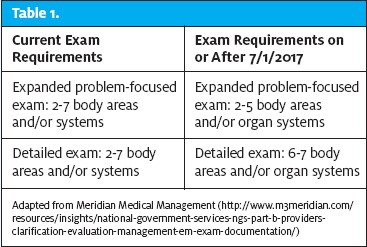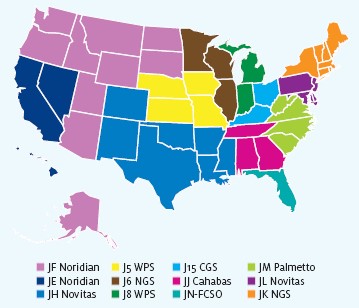Published on
Q: What is the difference between a detailed exam and an expanded problem-focused exam?
A: Unfortunately, there is no straightforward answer to that question. The Centers for Medicare and Medicaid Services (CMS) provides some guidance in the 1995 and 1997 guidelines (https://www.cms.gov/Outreach-and-Education/Medicare-Learning-Network-MLN/MLNProducts/MLN-Publications-Items/CMS1243514.html).
The 1995 guidelines state the documentation of the examination as follows:
- Problem-Focused – A limited examination of the affected body area or organ system.
- Expanded Problem-Focused –A limited examination of the affected body area or organ system and other symptomatic or related organ system(s).
- Detailed – An extended examination of the affected body area(s) and other symptomatic or related organ systems.
- Comprehensive – A general, multisystem examination or complete examination of a single organ system.
The 1997 guidelines are the same as 1995, except for added wording for related body area(s), as shown here:
- Expanded Problem-Focused – A limited examination of the affected body area or organ system and any other symptomatic or related body area(s) or organ system(s).
- Detailed – An extended examination of the affected body area(s) or organ system(s) and any other symptomatic or related body area(s) or organ system(s).
The 1997 guidelines employ a bullet (•) system, with each bullet representing an element for each of the system/body areas. From there, the guidelines go on to define each level of exam as:
- Problem-Focused – One to five elements identified by a bullet.
- Expanded Problem-Focused – At least six elements identified by a bullet.
- Detailed – At least two elements identified by a bullet from each of six areas/systems or at least 12 elements identified by a bullet in two or more areas/systems.
- Comprehensive – Perform all elements identified by a bullet in at least nine organ systems or body areas and document at least two elements identified by a bullet from each of nine areas/systems.
In many instances where descriptions are broad, as in this case, CMS allows Medicare administrative contractors (MACs) to create rules based on their interpretation of the issue. There are a few MACs that offer definitive guidance for determining the difference between an expanded problem-focused exam and a detailed exam.
The best example of this may be National Government Services (NGS), who has announced a change, effective July 1, 2017, that will provide a clear distinction between the expanded problem-focused exam and the detailed exam that should leave the provider and auditor with no doubt about which exam was documented. (See Table 1.)

Noridian Medicare interprets the 1995 guidelines for a detailed exam as five to seven body areas and/or organ systems and 12-17 bulleted elements for two (or more systems, using the 1997 guidelines) (https://med.noridianmedicare.com/web/jeb/education/act/act-qa-101916).
Palmetto GBA, Novitas Solutions, Cahaba GBA, CGS Administrators, LLC (CGS), Wisconsin Physicians Service (WPS), and First Coast Service Options Inc. (FSCO) all quote CMS 1995 and 1997 guidelines.
So, until the rest of the MACs get on board to better define the difference between an expanded problem focused exam and a detailed exam, or unless your practice happens to be in one of the states in the NGS or Noridian jurisdictions, the interpretation is left up to the provider. If not, I would suggest you create a policy that defines the difference, and make sure that all the providers in your practice document the exam according to that definition. Query your electronic medical record (EMR) or electronic health record (EHR) vendor on which guidelines are followed and how credit is given so you can educate your staff on what to expect when documenting in the record.
Here is the most recent map indicating the jurisdiction and MAC:


